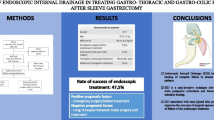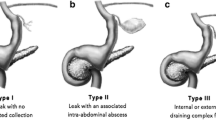Abstract
Background and Aims
The originality of this retrospective study relies on the evaluation of the effectiveness of the endoscopic internal drainage (EID) according to the type of fistula.
Methods
The type of fistula was classified initially according to a CT scan with oral opacification: fistula without a communicating abscess (type I), fistula with a communicating abscess (type II), and fistula with an abscessed sub- and sus-diaphragmatic communicating collection (type III). Treatment algorithm consisted of the insertion of a nasojejunal feeding tube (NJFT) for type I fistulas and the placement of a NJFT with EID with or without surgical drainage for types II and III.
Results
Forty-nine patients were included. The clinical success rate with fistula healing was 100% in group I, 96% in group II, and 12% for group III (p = 0.001). Mean time for diagnosis of the fistula was significantly higher in type III (p = 0.04). The mean estimated size of the defect was higher in type II, 11.2 mm and III, 10 mm versus type I, 2.8 mm (p = 0.001). The average number of scheduled endoscopic sessions were 2, 2.7, and 5.2 for types I, II, and III, respectively (p = 0.001). The number of unscheduled reinterventions was also significantly higher in type III (p = 0.03). The NJFT was left in place for a significantly longer duration in type III (136 days) compared to types I (3, 13) and II (49) p = 0.001.
Conclusion
This study shows that proper characterization of the type of fistula before the endoscopic treatment of post-sleeve fistulas improves the efficacy of the endoscopic treatment.







Similar content being viewed by others
References
Gagner M, Hutchinson C, Rosenthal R. Fifth International Consensus Conference: current status of sleeve gastrectomy. Surg Obes Relat Dis Off J Am Soc Bariatr Surg. 2016;12(4):750–6.
Berger ER, Clements RH, Morton JM, et al. The impact of different surgical techniques on outcomes in laparoscopic sleeve gastrectomies: the first report from the Metabolic and Bariatric Surgery Accreditation and Quality Improvement Program (MBSAQIP). Ann Surg. 2016;264(3):464–73.
Rosenthal RJ, International sleeve gastrectomy expert panel, Diaz AA, et al. International Sleeve Gastrectomy Expert Panel Consensus Statement: best practice guidelines based on experience of >12,000 cases. Surg Obes Relat Dis Off J Am Soc Bariatr Surg. 2012;8(1):8–19.
Al Hajj G, Chemaly R. Fistula following laparoscopic sleeve gastrectomy: a proposed classification and algorithm for optimal management. Obes Surg. 2017;
Murino A, Arvanitakis M, Le Moine O, et al. Effectiveness of endoscopic management using self-expandable metal stents in a large cohort of patients with post-bariatric leaks. Obes Surg. 2015;25(9):1569–76.
Christophorou D, Valats J-C, Funakoshi N, et al. Endoscopic treatment of fistula after sleeve gastrectomy: results of a multicenter retrospective study. Endoscopy. 2015;47(11):988–96.
Donatelli G, Dumont J-L, Cereatti F, et al. Treatment of leaks following sleeve gastrectomy by endoscopic internal drainage (EID). Obes Surg. 2015;25(7):1293–301.
Lorenzo D, Guilbaud T, Gonzalez JM, et al. Endoscopic treatment of fistulas after sleeve gastrectomy: a comparison of internal drainage versus closure. Gastrointest Endosc. 2017;
Bouchard S, Eisendrath P, Toussaint E, et al. Trans-fistulary endoscopic drainage for post-bariatric abdominal collections communicating with the upper gastrointestinal tract. Endoscopy. 2016;48(9):809–16.
Shoar S, Poliakin L, Khorgami Z, et al. Efficacy and safety of the over-the-scope clip (OTSC) system in the management of leak and fistula after laparoscopic sleeve gastrectomy: a systematic review. Obes Surg. 2017;27(9):2410–8.
Okazaki O, Bernardo WM, Brunaldi VO, et al. Efficacy and safety of stents in the treatment of fistula after bariatric surgery: a systematic review and meta-analysis. Obes Surg. 2018;28:1788–96.
Bruce J, Krukowski ZH, Al-Khairy G, et al. Systematic review of the definition and measurement of anastomotic leak after gastrointestinal surgery. Br J Surg. 2001 Sep;88(9):1157–68.
Nedelcu M, Skalli M, Delhom E, et al. New CT scan classification of leak after sleeve gastrectomy. Obes Surg. 2013 Aug;23(8):1341–3.
Author information
Authors and Affiliations
Contributions
A. Sportes: Design of the protocol, performance of endoscopic treatment, inclusion of patients, collection of data, preparation of the manuscript
G. Aireini: Performance of endoscopic treatment, inclusion of patients, collection of data
R. Kamel: Preparation of the manuscript
C. Pratico: Performance of endoscopic treatment
JJ. Raynaud: Inclusion of patients, collection of data
JM. Sabate: Revision of the manuscript, statistical analysis
G. Donatelli: Performance of endoscopic treatment, revision of the manuscript
R. Benamouzig: Design of the protocol, revision of the manuscript
Corresponding author
Ethics declarations
This retrospective study was approved by the local ethics committee of the Assistance Publique des Hôpitaux de Paris.
Conflict of Interest
The authors declare that they have no conflicts of interest.
Additional information
Publisher’s Note
Springer Nature remains neutral with regard to jurisdictional claims in published maps and institutional affiliations.
Rights and permissions
About this article
Cite this article
Sportes, A., Aireini, G., Kamel, R. et al. Efficacy of Endoscopic Treatment of Post-Sleeve Gastrectomy Fistulas According to the Radiological Type. OBES SURG 29, 2217–2224 (2019). https://doi.org/10.1007/s11695-019-03825-4
Published:
Issue Date:
DOI: https://doi.org/10.1007/s11695-019-03825-4




